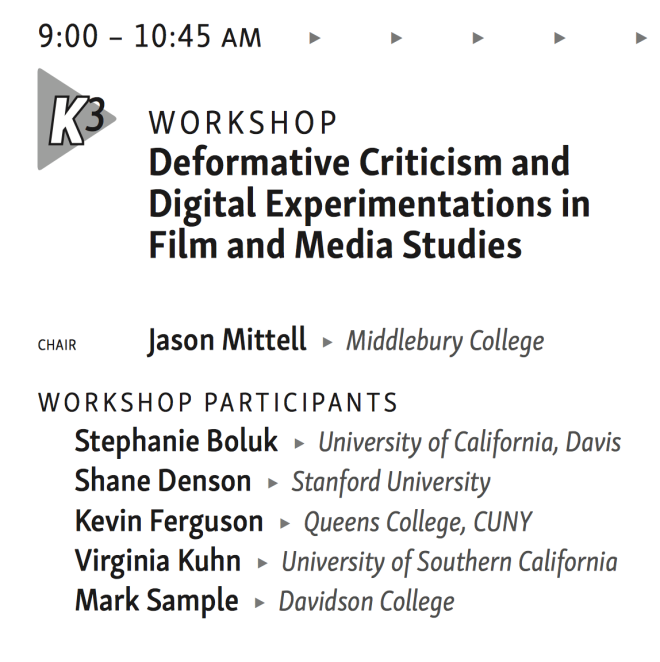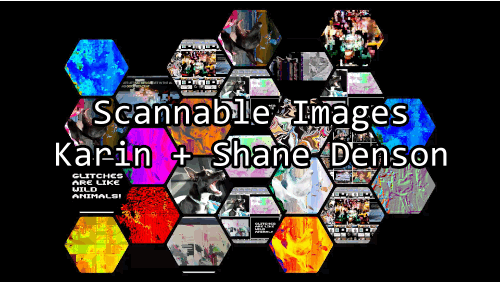
If you’re in Chicago for the Society for Cinema and Media Studies conference this week, come check out our workshop on “Deformative Criticism and Digital Experimentations in Film and Media Studies” on Friday, March 24 at 9am. More info here.

If you’re in Chicago for the Society for Cinema and Media Studies conference this week, come check out our workshop on “Deformative Criticism and Digital Experimentations in Film and Media Studies” on Friday, March 24 at 9am. More info here.
The conference program for the 2017 SCMS conference in Chicago is now available online (opens as PDF). As I mentioned recently, I will be participating in panel K3 (Friday, March 24, 2017, 9:00-10:45am) — a workshop dedicated to “Deformative Criticism and Digital Experimentations in Film & Media Studies.”

At the upcoming SCMS conference in Chicago, I will be participating in a workshop on “Deformative Criticism and Digital Experimentations in Film & Media Studies” (panel K3 on Friday, March 24, 2017 at 9:00am):
Deformative criticism has emerged as an innovative site of critical practice within media studies and digital humanities, revealing new insights into media texts by “breaking” them in controlled or chaotic ways. Deformative criticism includes a wide range of digital experiments that generate heretical and non-normative readings of media texts; because the results of these experiments are impossible to know in advance, they shift the boundaries of critical scholarship. Media scholars are particularly well situated to such experimentation, as many of our objects of study exist in digital forms that lend themselves to wide-ranging manipulation. Thus, deformative criticism offers a crucial venue for defining not only contemporary scholarly practice, but also media studies’ growing relationship to digital humanities.
Also participating in the workshop will be Jason Mittell (Middlebury College), Stephanie Boluk (UC Davis), Kevin L. Ferguson (Queens College, City University of New York), Mark Sample (Davidson College), and Virginia Kuhn (USC).
My own presentation/workshop contribution will focus on glitches and augmented reality as a deformative means of engaging with changing media-perceptual configurations, including the following case study:
Glitch, Augment, Scan
Scannable Images is a collaborative art/theory project by Karin + Shane Denson that interrogates post-cinema – its perceptual patterns, hyperinformatic simultaneities, and dispersals of attention – through an assemblage of static and animated images, databending and datamoshing techniques, and augmented reality (AR) video overlays. Viewed through the small screen of a smartphone or tablet – itself directed at a computer screen – only a small portion of the entire spectacle can be seen at once, thus reflecting and emulating the selective, scanning regard of post-cinematic images and confronting the viewer with the materiality of the post-cinematic media regime through the interplay of screens, pixels, people, and the physical and virtual spaces they occupy.
At the upcoming conference of the Society for Cinema and Media Studies (March 6-10, 2013 in Chicago), I will be participating in a panel on “post-cinematic affect” with Steven Shaviro (who, literally, wrote the book on the topic), Therese Grisham (who organized a great roundtable discussion on the topic in La Furia Umana, which I was also proud to be a part of — and which can alternatively be found here if La Furia Umana is down), and Julia Leyda (who also participated in the roundtable and will serve as respondent on our SCMS panel).
Here is a description of our panel, which is scheduled for Thursday, March 7, from 3:00 – 4:45 pm (Session H):
Post-Cinematic Affect: Theorizing Digital Movies Now
If cinema and television, as the dominant media in the twentieth century, shaped and reflected our cultural sensibilities, how do new digital media in the twenty-first century help to shape and reflect new forms of sensibility? Continuing from roundtable discussions on “post-cinematic affect” in the online film journal La Furia Umana, this panel explores the emergence of a new “structure of feeling” (Raymond Williams) or “episteme” (Foucault) in post-millennial film, one that is evident in new formal strategies, radically changed conditions of viewing, and new ways in which films address their spectators. Contemporary films, from blockbusters to independents and the auteurist avant-garde, use digital cameras and editing technologies, incorporating the aesthetics of gaming, webcams, and smartphones, to name a few, as well as Internet media. For this reason alone, we argue, the aesthetic boundaries between art-house film and blockbuster have become blurred. Moreover, the aesthetic elements of contemporary film do not just simulate the environments created by digital technologies and media, but break more radically with the geometry and logic of films in the twentieth century. In this way, they reflect or transmit the effects, not only of digitization, but also of economic globalization and the financialization of more and more human activities. But these changes have only begun to be theorized. In this panel, we continue the work of theorizing a critical aesthetics of film culture today. The papers take as their critical starting-points David Bordwell on “intensified continuity,” Matthias Stork on “chaos cinema,” and Steven Shaviro on post-cinematic affect and “post-continuity.”
The papers explore key critical issues for analyzing post-cinematic affect, in terms of the ambivalent aesthetics of recent films exhibiting a longing for cinema as the lost object of desire (Therese Grisham on Martin Scorsese’s Hugo), post-continuity stylistics (Steven Shaviro on Tony Scott’s films, particularly his 2005 Domino), and philosophical and technological approaches to the contemporary camera (Shane Denson on images “discorrelated” from human sense ratios in a variety of recent films).
Bibliography:
Bordwell, David. “Intensified Continuity: Visual Style in Contemporary American Film.” Film Quarterly, Vol. 55, No. 3. (Spring, 2002), pp. 16–28.
Grisham, Therese, with Julia Leyda, Nicholas Rombes, and Steven Shaviro. “Roundtable Discussion on the Post-Cinematic in Paranormal Activity and Paranormal Activity 2.” http://www.lafuriaumana.it/index.php?option=com_content&view=article&id=385:roundtable-discussion-about-post-cinematic&catid =59:la-furia-umana-nd-10-autumn-2011&Itemid=61
Shaviro, Steven. “Post-Continuity”. Blog posting: The Pinocchio Theory, March 26, 2012, http://www.shaviro.com/Blog/?p=1034
Shaviro, Steven. Post-Cinematic Affect. Winchester: Zer0 Books, 2010.
Stork, Mattias. “Video Essay: Chaos Cinema: The Decline and Fall of Action Filmmaking.” IndieWire, Press Play, August 24, 2011. Retrieved on August 30, 2012.
http://blogs.indiewire.com/pressplay/video_essay_matthias_stork_calls_out_the_chaos_cinema
Finally, here are links to the individual abstracts:
Therese Grisham, “Martin Scorsese and Hugo (2011): Our Reluctant Contemporaries”
Steven Shaviro, “Angel of Fire: Post-Continuity in Tony Scott’s Domino (2005)”
Here is the abstract for Therese Grisham’s paper on the panel “Post-Cinematic Affect: Theorizing Digital Movies Now” at the 2013 SCMS conference (Session H — Thursday, March 7, 2013, 3:00 – 4:45 pm):
Martin Scorsese and Hugo (2011): Our Reluctant Contemporaries
Therese Grisham
If our filmmakers now employ digital technologies that give rise to new aesthetic forms, reluctant stragglers long for a lost cinematic object. In 2011, a spate of movies was released whose aesthetic structures exhibit a yearning for earlier, cinematic forms, using digital technologies to “make them new” for contemporary audiences. While many of these movies digitally re-create older genres and styles, the acclaimed Hugo and The Artist re-create founding moments of cinema itself. This fact alone underlines our definitive entry into the episteme of the post-cinematic. Meticulously re-creating and re-staging the life and work of Georges Méliès, Martin Scorsese’s Hugo is unabashedly at once a “nostalgia film” (Jameson), an ode to the cinematic, and a pastiche of pre-cinema and cinema history. Much of this history is deliberately anachronistic, which can be seen clearly in light of Scorsese’s decision to employ digital 3D technologies to refer not only to the early fascination with three-dimensional images, but to the pervasive 3D movies in the 1950s — the most privileged moment figured in American nostalgia films. It can be argued that this pastiche provokes thought about the history of cinema (Sprengler); it can perhaps more pointedly be argued that the film offers up cultural stereotypes of the past (Jameson), its cinema history belonging to an obsolete, patriarchal textbook.
Hugo‘s digital techniques of production and post-production are at odds with its formal properties. I argue that Hugo combines innovations in digital 3D technologies with a classical narrative, a love of paraphernalia presaging cinematic motion (automata and wind-up toys, e.g.), and a “hyperrealistic” aesthetics of movement, space, color, and pattern. I borrow the term hyperrealism from painting, as a style that focuses on details and subjects, veering into the fantastic. Digital 3D is at its optimum when presenting (“real” or “imagined”) spatial detail and close-ups.
Scorsese ultimately suggests that he is the “father” of the digital trick film, and that Hugo is his most elaborate example so far. Hugo is offered to us as a contemporary founding moment in the history of film; nevertheless, its aesthetics, despite their technical innovations, hearken back to a world in which older technologies — and older forms of social authority — persist in the face of newer ones still struggling to be born.
Bibliography:
Cook, Adam. “Past/Not Past: A Tale of Two Cinemas.” In: MUBI Notebook, February 12, 2012. http://mubi.com/notebook/posts/pastnot-past-a-tale-of-two-cinemas
Evans, Seth. “Hugo.” In: Jon Fauer’s Film and Digital Times: The Journal of Art, Technique and Technology in Motion Picture Production Worldwide, November 11, 2011.
Jameson, Fredric. Postmodernism, or, The Cultural Logic of Late Capitalism. Durham, NC: Duke University Press, 1990.
Shaviro, Steven. Post-Cinematic Affect. Winchester: Zer0 Books, 2010.
Sprengler, Christine. Screening Nostalgia: Populuxe Props and Technicolor Aesthetics in Contemporary American Film. Oxford and New York: Berghahn Books, 2011.
Here is the abstract for Steven Shaviro’s paper on the panel “Post-Cinematic Affect: Theorizing Digital Movies Now” at the 2013 SCMS conference (Session H — Thursday, March 7, 2013, 3:00 – 4:45 pm):
Angel of Fire: Post-Continuity in Tony Scott’s Domino (2005)
Steven Shaviro
The late Tony Scott was a mainstream Hollywood director: a maker of big-budget, crowd-pleasing action films featuring major stars. But he was also one of the filmmakers who most thoroughly explored the new formal and expressive possibilities offered by recent digital technologies. His movies are filled with dazzling displays of virtuosity in cinematography and editing, even as they tell stories that largely follow well-established genre norms. Scott’s films utilize all the traditional mechanisms of narrative organization and audience identification with characters, but they also engage in an aggressively digressive “cinema of attractions.” This odd combination of effects and affects has caused Tony Scott to be celebrated and cherished by some cineastes, and reviled by many more. In my talk, I will explore Tony Scott’s “disjunctive synthesis” of old and new — a synthesis that is not only seen on the level of diegetic form (narrative structure vs. attractions), but also on that of the technological means of cinematic production (century-old hand-cranked cameras vs. heavy digital processing) and on that of the ways that technology is represented within the films (a love for older technologies such as trains vs. a radical immersion in video and Internet-based technologies). I will argue that Scott’s adoption of a “post-continuity” style (going beyond the limits of what David Bordwell calls “intensified continuity”) works to embody and express the explosive tensions of what I have elsewhere called “post-cinematic affect.” This style does two things. On one hand, it expresses the only possible form of subjectivity in a world in which, as Deleuze puts it, “the image constantly sinks to the state of cliché.” On the other, it renders, in audiovisual forms, the impalpable circulation of money, affects, and other forms of value in the post-spectacular society of 21st-century America. My talk will center on Domino (2005), Scott’s most audiovisually extravagant and audacious (and commercially least successful) film.
Bibliography:
Bordwell, David. “Intensified Continuity: Visual Style in Contemporary American Film.” Film Quarterly, Vol. 55, No. 3. (Spring, 2002), pp. 16–28.
Deleuze, Gilles. Cinema 2 (1989). Trans. Hugh Tomlinson and Robert Galeta. University of Minnesota Press.
Knapp, Larry. “Tony Scott and ‘Domino’: Say Hello (and Goodbye) to the Post-classical”. Jump Cut 50, 2008. Available online at http://www.ejumpcut.org/archive/jc50.2008/DominoKnapp/index.html
Stork, Matthias. “Acid Aesthetics: Tony Scott’s Cinema of Chaos”, SWTX Popular and American Culture Conference, Albuquerque, New Mexico, February 2012.
Vishnevetsky, Ignatiy. “Smearing the Senses: Tony Scott, Action Painter”. August 22, 2012, http://mubi.com/notebook/posts/smearing-the-senses-tony-scott-action-painter